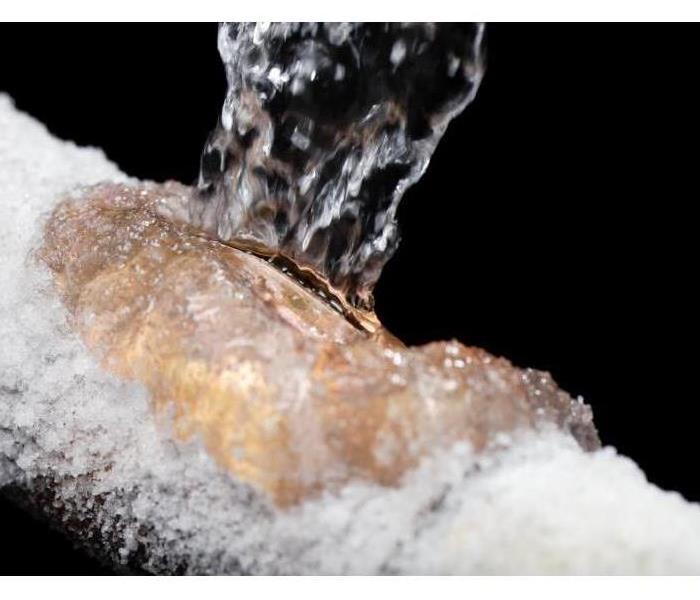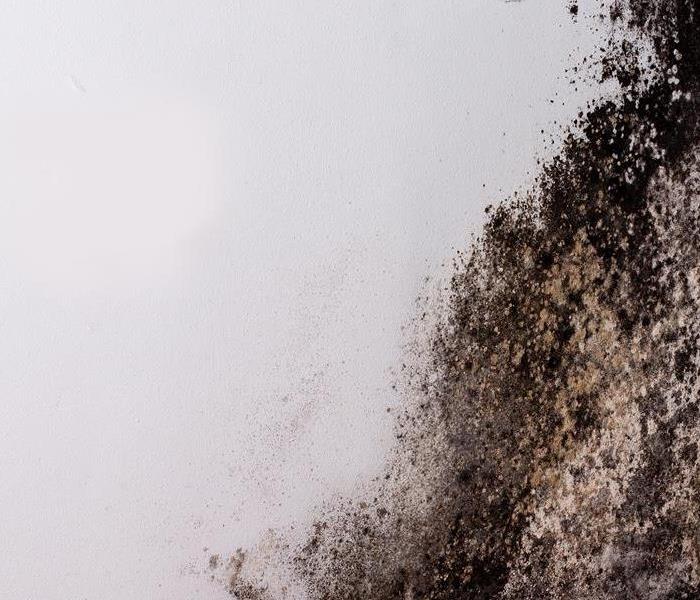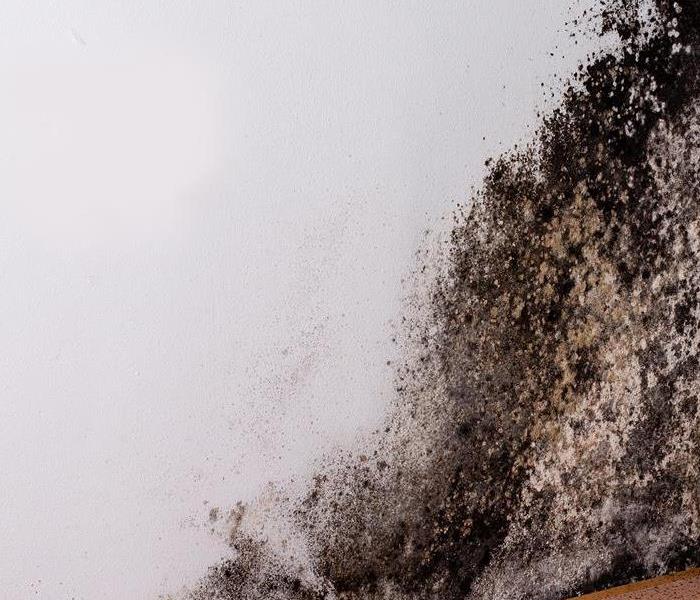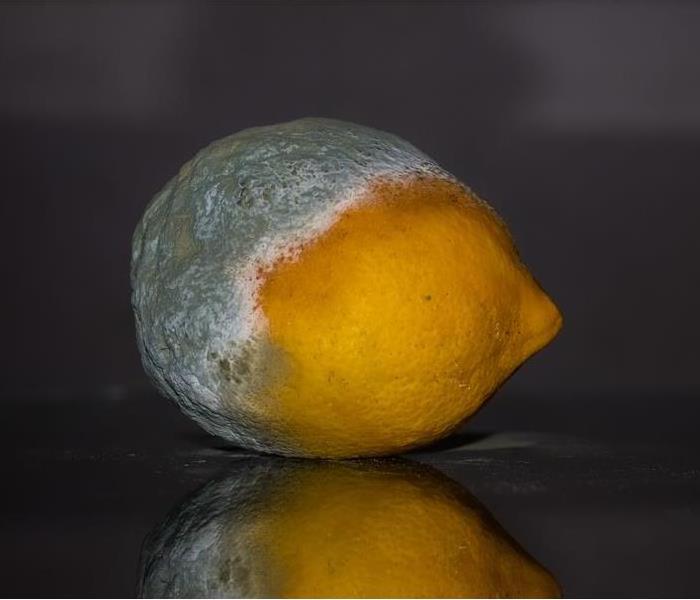Archived Mold Remediation Blog Posts
Understanding Black Mold
1/23/2024 (Permalink)
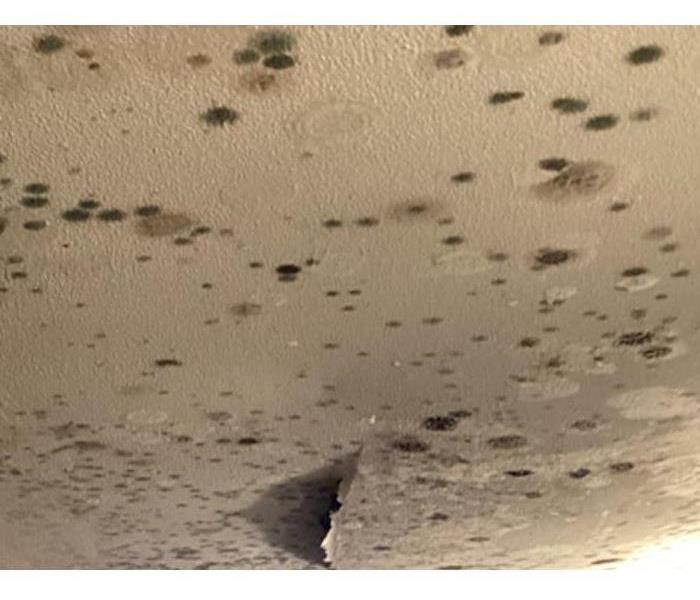 Black mold growing on ceiling, potentially compromising the integrity of the building
Black mold growing on ceiling, potentially compromising the integrity of the building
What is Black Mold, and Why is it a Concern?
Black mold, scientifically known as Stachybotrys chartarum, is a toxic mold variant that thrives in damp, humid conditions. Often characterized by its dark coloration, this mold is not just an aesthetic concern but poses significant health and structural risks. Its spores, when airborne, can exacerbate respiratory problems, allergies, and even lead to more severe health issues, particularly in those with compromised immune systems. Beyond health risks, black mold can also undermine the structural integrity of buildings, leading to costly repairs and devaluation of property. It is crucial for home and business owners to understand the gravity of black mold infestations and take proactive measures to mitigate its growth and spread.
Primary Causes of Black Mold Growth in Buildings
Understanding the root causes of black mold growth is essential for effective prevention and treatment. Primarily, black mold thrives in environments that provide moisture, organic material, and adequate temperatures.
- Moisture: The predominant factor for black mold growth is excess moisture, which can originate from several sources such as leaking pipes, roof leaks, condensation, or high indoor humidity. Buildings with poor drainage systems or those that have experienced flooding are particularly susceptible.
- Poor Ventilation: Inadequate ventilation in buildings leads to moisture accumulation, especially in high-humidity areas like bathrooms and kitchens. This lack of airflow not only supports mold growth but also prevents the drying out of damp areas, further exacerbating the problem.
- Building Materials: Black mold feeds on organic materials found in many building components like wood, drywall, and insulation. These materials, when exposed to moisture, provide the perfect breeding ground for mold.
- Temperature: Mold thrives in warm temperatures, typically found indoors. Buildings with inconsistent temperature regulation or poor insulation can have pockets of warmth that encourage mold growth.
Addressing these key factors is crucial in preventing and managing black mold in any building. By controlling moisture levels, ensuring proper ventilation, and using mold-resistant building materials, the risks associated with black mold can be significantly mitigated.
Identifying Early Signs of Black Mold
Early detection of black mold is crucial in preventing its spread and mitigating potential health risks. Being vigilant about the signs can help in taking timely action. Here are key indicators to watch for:
- Visible Growth: The most obvious sign is the appearance of dark, often black or greenish-black, splotches on surfaces, particularly in moist areas like bathrooms, kitchens, and basements.
- Musty Odors: A persistent musty, earthy smell is a strong indicator of mold presence, even if it's not immediately visible. This odor can be particularly noticeable in closed spaces or upon entering a room.
- Water Damage: Signs of water damage such as water stains, discoloration, or peeling wallpaper/paint can indicate potential mold growth areas, especially if the area remains damp.
- Health Symptoms: Unexplained allergic reactions like sneezing, sore eyes, nasal congestion, or skin irritation when at home may suggest mold presence. People with asthma or respiratory conditions may notice worsening symptoms.
- Humidity and Condensation: Excessive humidity and condensation on windows, pipes, or walls create ideal conditions for mold growth. Regular monitoring of these areas can help in early detection.
Regular inspections, particularly in prone areas, are essential in catching mold growth early. If any signs are detected, it’s advisable to seek professional assessment to determine the extent and necessary remediation steps.
Effective Strategies for Preventing Black Mold Growth
Preventing black mold growth is more manageable than dealing with its aftermath. Implementing effective strategies can significantly reduce the risk of mold infestation in any building. Here are some key preventive measures:
- Control Humidity Levels: Maintain indoor humidity levels between 30-50% using dehumidifiers and air conditioners. This range hinders mold growth.
- Enhance Ventilation: Increase airflow in high-moisture areas like bathrooms and kitchens by using exhaust fans and keeping windows open when possible.
- Immediate Water Damage Response: Address water leaks and spills promptly. The faster you dry the area, the lesser the chance for mold to grow.
- Regular Maintenance Checks: Conduct routine inspections for leaks in roofs, pipes, and walls. Early detection and repair of these issues can prevent mold proliferation.
- Use Mold-Resistant Products: When building or renovating, consider using mold-resistant drywall, paints, and building materials, especially in moisture-prone areas.
- Keep Spaces Clean and Dry: Regular cleaning and vacuuming with HEPA filters can reduce mold spores in the home. Ensure that areas like bathrooms and basements are well-ventilated and dry.
- Proper Insulation: Ensure your home is properly insulated, including windows, doors, and pipes, to reduce the chances of condensation which can lead to mold growth.
Implementing these strategies creates an environment that is not conducive to mold growth, thus safeguarding the structural integrity of the building and the health of its occupants.
Conclusion
Combatting black mold effectively hinges on awareness and proactive prevention. Recognizing the early signs and understanding the causes is vital for maintaining a healthy environment in our homes and businesses. Simple measures like controlling humidity, ensuring good ventilation, and addressing water-related issues promptly can significantly deter mold growth. Regular maintenance and vigilance are key.
Need Expert Mold Remediation? Contact SERVPRO® Today
If you're facing mold challenges in your home or business, don't wait for the problem to escalate. SERVPRO of Washington County's professional mold remediation services are your solution. Our team of experts is equipped with the knowledge, tools, and experience to efficiently identify, address, and prevent mold issues, ensuring your environment is healthy and safe. Trust SERVPRO of Washington County to provide effective, thorough, and timely mold remediation services. Read more about our mold remediation services or give us a call today!
The Sneaky Characteristics of Mold | SERVPRO of Washington County
8/17/2023 (Permalink)
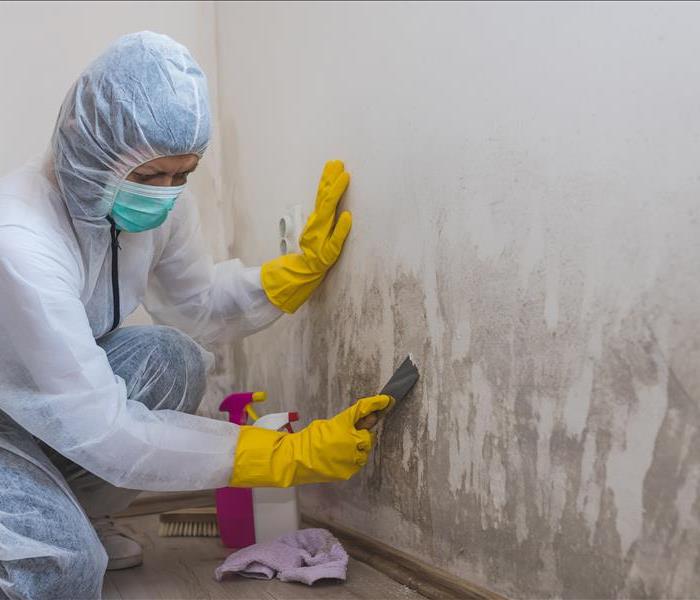 Has your home been impacted by mold? Call SERVPRO of Washington County to restore your home's health!
Has your home been impacted by mold? Call SERVPRO of Washington County to restore your home's health!
Being a homeowner is a lot of work, but that work is definitely worth it in the long run. You are constantly running around cleaning, repairing, tinkering and troubleshooting no matter what time of year it is! That’s why it can be easy to overlook seemingly innocuous things such as minor water spots or a humid part of your home that doesn’t ever seem to dry out.
Unfortunately, those unsuspecting places are also where serious mold situations can grow, and they can often become full infestations in a matter of days. If you discover mold in your Hagerstown home, call SERVPRO® of Washington County for immediate assistance.
Where Does Mold Start Growing?
Mold is basically everywhere all the time. It floats through the air in microscopic spores both indoors and outdoors and can easily transfer back and forth through open windows, vents or air leaks anywhere in your home.
While it is found everywhere, it doesn’t grow everywhere. Mold only likes to grow in spaces that are dark, moist and a little warm. If a mold spore makes it into an area like that, it can grow into a colony in as little as 48 hours. Common places for infestations tend to be places that have a hard time drying out completely, like your bathroom, attic and crawl spaces.
How to React When You Discover Mold
Many people’s first reactions are probably along the lines of “ew” followed by a discussion on how to clean it up. We really recommend not disturbing the mold yourself.
Sometimes mold spores can be dangerous, so it is best to leave it to the professionals to investigate for you. We will determine the type of mold it is and we will also investigate any moisture problems that caused the spores to take hold in the first place.
We first work to contain the mold and filter the air to get any residual spores out. This also helps remove the odor as mold often produces a musty, earthy smell that can linger even after the mold is gone. Then we will sanitize the entire space to ensure the mold can’t grow back.
From there, we will work on restoring any possessions that were impacted by the mold. Keep in mind that not everything can be saved once mold starts to grow, but we do our best to restore whatever we can and clean to the best of our ability. Finally, we will seal up any air leaks or gaps that caused the water leak or moisture issue in the first place.
The Repair Process
Mold has the ability to cause widespread damage in a short amount of time. Coupled with the lingering moisture, mold can degrade beams and internal structures, rust metal and rot wood and other materials in your home. This can sometimes make your living areas unsafe to be in even after the mold is gone.
We can repair whatever the mold ruined quickly and thoroughly to return your home back to its pre-mold condition. You can count on us when mold is discovered on your property!
We are ready to help you overcome a mold problem. Contact SERVPRO of Washington County right away.
Carpet Cleaning Services
8/16/2018 (Permalink)
Summer is the best time to be in Rhode Island. But the trips to the beach, the increased foot traffic, playing in the yard and the overall humididty can be tuff on carpets leaving them damp and dirty with debris.
We can help.
SERVPRO professionals are available to clean, renew and help protect your carpets. We offer complete carpet and upholstry cleaning services to residents and businesses in Rhode Island & Connecticut.
Because our techs are professionally trained to remediate disasters like fire, water damage, smoke damage and more we are already equiped and prepared to offer commercial grade cleaning services right in your neighborhood. And, because we have decades of experience we offer service and products unmatched by other carpet cleaning services. Contact our office today for a no obligation estimate.
Winter Water Damage
12/7/2017 (Permalink)
In the wintertime, we tend to forget about mold becoming an issue in the home. For the most part, we associate mold with humid summer days creating the perfect environment for mold growth in dark, damp spaces… but this is not always the case. For example, mold growth can strike quickly after a flood or fire even in the winter. We recently encountered a home in which the pipes had burst on the third floor of the dwelling. With no one home, the water soaked the home for 2 days before the leak was discovered. Our crew began working in the home within 72 hours of the disaster and within that time mold growth could be seen on wet surfaces throughout the house. If not properly treated mold can quickly make its way into difficult to find places like vents and ducts where it may cause health issues to those in the home if not removed.
Revitalizing Old Buildings? You Might Find Mold.
11/30/2017 (Permalink)
Finding mold in your home or commercial property is a precarious situation. Sometimes it may be a localized outbreak that can be easily cleaned away, other times what appears to be a small patch of mold is an indication of a much bigger issue that could be hazardous to the health of those living in the home. SERVPRO of Washington County’s mold remediation is second to none and will evaluate and remediate mold outbreaks.
As many areas in the US see continued growth many old, unoccupied commercial buildings are now opening their doors again. If you encounter mold in your new commercial property SERVPRO of Washington County can help. Call our office today and we can send an experienced technician to review your mold issue.
2017 Mold Report & Preparation
7/1/2017 (Permalink)
Nationwide 2017 has been a unique year for weather. Across the country cities and towns have been stressed by the weather extremes from snowfall accumulating in 48 of 50 states to almost non-stop rain storms and flooding throughout the spring in some areas. The next battle will be the warm summer months and mold will be a new challenge as a result of the spring weather. SERVPRO technicians everywhere are getting prepared for what they believe will be an above average year for mold contamination in homes and commercial properties everywhere.
In New England states like Rhode Island, Connecticut, and Massachusetts many homes and commercial properties will have mold issues, especially in basements and lower levels. These areas tend to get very little light and remain damp even when the temperature rises creating the perfect environment for mold to thrive.
If you believe your home, office or commercial building could be experiencing mold issues call us today! 401-315-2337
How to Prevent Mold
4/19/2017 (Permalink)
Mold can grow everywhere, from your carpet to your window seals, and even inside of your walls! Sometimes it is easy to detect mold, and other times it’s more difficult. While it is impossible to completely eliminate mold, here are some tips on how to prevent mold from growing.
Dry Wet Areas
Mold needs moisture to grow. You can help prevent mold from growing by wiping away condensation and by not leaving wet items around. Always make sure you wipe down the bathroom after you shower and hang wet towels in a room with good air circulation to dry.
Proper Ventilation
Poor ventilation allows water to stay in the area and may help mold grow. If you are doing an activity that produces a lot of moisture, like cooking, make sure you are using the exhaust fan. You can always open up a window in addition to using an exhaust fan.
Monitor Humidity
The EPA recommends indoor air humidity should be between 30 and 60 percent. You can keep an eye on humidity levels in your home with a moisture meter which can be picked up at your local hardware store.
If your home has high humidity levels, you may want to get a dehumidifier. This will help keep humidity levels down.
Direct Moisture Away from your Home
If your property constantly is flooded, you may want to develop a way to prevent water from getting inside of your home. This will help prevent water damage and it may help prevent mold from growing inside of your home. This can be done in a few ways.
- Create a barrier
- Dig a trench
- Build a dry well
If you suspect that you have mold growing in your home, call SERVPRO. The experts at SERVPRO will inspect and assess your property with our specialized training and equipment. We will make your property look “Like it never even happened”.






 24/7 Emergency Service
24/7 Emergency Service



